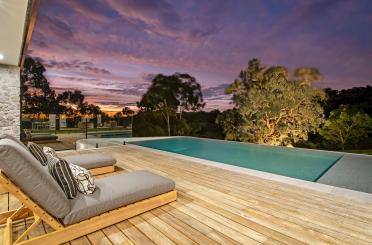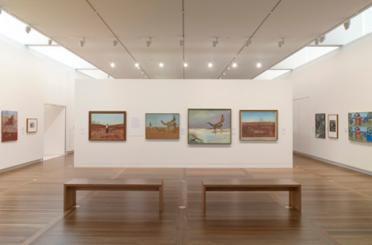Turpentine is an extremely hard and durable Australian native hardwood timber. It is suitable for a wide range of construction and engineering applications.
Luster, Red Luster, Syncarpia Laurifolia
Syncarpia Glomulifera

Shrinkage
| Very Low | Low | Medium | High | Very High | |
|---|---|---|---|---|---|

|

|
||||
Tangential : |
13.00%
|
||||
Radial : |
6.50%
|
||||
Unit Movement Tangential: |
0.35%
|
||||
Unit Movement Radial: |
0.23%
|
Strength Group

Very High |
High |
Reasonably High |
Medium High |
Medium |
Reasonably Low |
Low |
Very Low |
||
Unseasoned: |
S1 |
S2 |
S3 |
S4 |
S5 |
S6 |
S7 |
S8 |
|
|---|---|---|---|---|---|---|---|---|---|
 |
|||||||||
Seasoned: |
SD1 |
SD2 |
SD3 |
SD4 |
SD5 |
SD6 |
SD7 |
SD8 |
|
 |
Stress Grade

| Structural No. 1 |
Structural No. 2 |
Structural No. 3 |
Structural No. 4 |
Structural No. 5 |
|
Unseasoned: |
F17 |
F14 |
F11 |
F8 |
F7 |
Seasoned: |
F27 |
F22 |
F17 |
F14 |
F11 |
Density per Standard

Seasoned: |
945kg/m3
|
|---|---|
Unseasoned: |
1170kg/m3
|
Joint Group

Very High |
High |
Reasonably High |
Medium |
Low |
Very Low |
|
Unseasoned: |
J1 |
J2 |
J3 |
J4 |
J5 |
J6 |
|---|---|---|---|---|---|---|
 |
||||||
Seasoned: |
JD1 |
JD2 |
JD3 |
JD4 |
JD5 |
JD6 |
 |
Colour

| White, yellow, pale straw to light brown | Pink to pink brown | Light to dark red | Brown, chocolate, mottled or streaky | |
 |
||||
Mechanical Properties
Modulus of Rupture - Unseasoned: |
79
|
|---|---|
Modulus of Rupture - Seasoned: |
136
|
Modulus of Elasticity - Unseasoned: |
12
|
Modulus of Elasticity - Seasoned: |
15
|
Maximum Crushing Strength - Unseasoned:  |
43
|
Maximum Crushing Strength - Seasoned: |
79
|
Impact - Unseasoned: |
15
|
Impact - Seasoned: |
10
|
Toughness - Unseasoned: |
Medium - 15 - 24 Nm
|
Toughness - Seasoned: |
Medium - 15 - 24 Nm
|
Hardness - Unseasoned: |
6.7
|
Hardness - Seasoned: |
11.6
|
Durability
| Low | Moderate | Reasonably High | High | |
| (0 - 5 yrs) | (5 - 15 yrs) | (15 - 25 yrs) | (more than 25 yrs) | |
In-Ground: |
 |
|||
| (0 - 7 yrs) | (7 - 15 yrs) | (15 - 40 yrs) | (More than 40 yrs) | |
Above ground: |
 |
|||
| (0 - 20 yrs, usually < 5) | (21 - 40 yrs) | (41 - 64 yrs) | (More than 60 yrs) | |
Marine Borer Resistance: |
 |
Lyctid Borer Susceptibility: |
Not Susceptible |
|---|---|
Lyctid Borer Susceptibility - Other: |
|
Termite Resistance: |
Resistant
|
Fire Properties
| 0 | 1 | 2 | 3 | 4 | 5 | 6 | 7 | 8 | 9 | 10 | |
EFH Spread-of-Flame Index: |
|||||||||||
EFH Smoke-Developed Index: |
Critical Radiance Flux - Lower: |
>2.2 and <4.5 |
|---|---|
Critical Radiance Flux - Higher: |
≥4.5 |
Smoke Development Rate: |
<750
|
| 1 - non-combustible | 2 - reasonably non-combustible | 3 - slightly combustible | 4 - combustible | |
Fire Properties Group |
Average Specific Extinction Area: |
<250
|
|---|---|
Bushfire Resistance: |
BAL 12.5, 19 and 29 – All AS3959 required applications
|

Decking

Fencing

Structural Timber Poles

Flooring
Allied Forest Products

Australian Solar Timbers
Australian Timber

Classy Timber Flooring

Coffs Harbour Hardwoods
Decking Perth

Floors of Distinction

Garde Timber Pty Ltd

Matilda Veneer

Outlast Timber Supplies

Pentarch Forestry

Ridgewood Timber Pty Ltd

Sawmill Trading Company

Simmonds

The Log Factory

Thor’s Hammer








